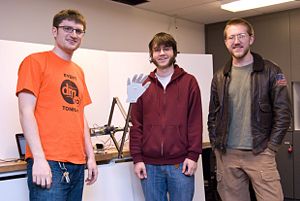High Speed Motor Control
Overview
The project suggested was to design a system for high speed motor control using the PIC 32. To demonstrate the motor control, a two degree of freedom (2DOF) robot arm was designed to follow paths specified in a MATLAB gui.
Team Members
- Sam Bobb (Electrical Engineering senior, left)
- Daniel Cornew (Mechanical Engineering junior, right)
- Ryan Deeter (Mechanical Engineering junior, middle)
Mechanical Design
Theory of Parallelogram Design
Equations of Motion
Commanding the arm is much easier for a user to do in x- and y- coordinates than in motor angles or encoder counts. Therefore, equations were required that would translate x- and y- coordinates into angles from horizontal and then into encoder counts. Equations to express the reverse (encoder counts to angles to x- and y- coordinates) were also needed to evaluate the accuracy of the execution with respect to the command path.
Note: is used to calculate in the MATLAB code and is not ever sent to the PIC.
Materials and Construction
The arm is constructed from aluminum and carbon fiber. These materials were chosen due to their light weight and their availability. The extended link of the arm is made of carbon fiber, as are two of the other supporting links. The final link is made from bent aluminum sheet because that link houses two bearings and removing
Electrical Design
Overview
Components
Circuit Diagram
GUI
The GUI used to control the arm was programmed in MATLAB using the "guide" function. The GUI code calls the other MATLAB functions and is rather small as far as the amount of new code in contains.
[insert screenshot of gui]
Usage
The GUI is made up of four main sections that allow a user to control the path and motor control parameters of the arm and plot the results.
The first section is the "Path" section, which allows users to specify the type of path the arm will follow. There are currently three path choices: "go to," "circle," and "trace." The "go to" path allows the user to specify a point that the arm will go to from its current position in five seconds. The "circle" path is determined through five values. The first two are the (x, y) of the center of the circle. The next two are coefficients on sin and cosine terms that are effectively the radii [CHECK THIS WITH SAM}. The last value is the time in seconds for the arm to complete the circle. In the final path, "trace," users input four (x, y) positions and the arm moves from the first to the fourth and back to the first with two seconds in between points. The GUI could easily be changed so that the user specifies (x, y, t) and controls the time between points, but this would require velocity-based failure checking in the code to ensure that the user did not give a command that was dangerous to the arm.
The section just to the right of the "Path" section allows for further manipulation of the path and motor control. A checkbox controls whether or not the specified path loops (note: "go to" cannot loop). Beneath the checkbox is a section labeled "PID Control" and it lets users adjust the coefficients kp (proportional), ki (integral) and kd (derivative) on the fly by pressing the "Update" button.
The section on the far right is used to communicate between MATLAB and the PIC. A COM port is specified for communication. The "Connect" button opens the COM port, and the "Disconnect" button closes it. The "Start" button runs whichever path is specified in the "Path" section, and "Pause" pauses the path (note: to unpause, click the "Start" button again while paused).
The final section of the GUI is the "Graphs" section. This section plots the path of the arm in either "theta vs t" or "x vs y," as selected by the radio buttons. Plotted in COLOR is the path that the PIC tried to execute, and the COLOR plot shows the actual path of the arm, for comparison. INCLUDE SOMETHING ABOUT THE GET DATA AND CONTINUOUS LOG BUTTONS!
Code
Using MATLAB's "guide" function when creating GUIs makes for rather straightforward coding. When a component is added to the GUI (be it a button, text field, etx.), MATLAB adds a block of code to an automatically generated m-file. These blocks are functions, which means that programming them requires the use of handles. Here is an example:
function xCoor_Callback(hObject, eventdata, handles)
% hObject handle to xCoor (see GCBO)
% eventdata reserved - to be defined in a future version of MATLAB
% handles structure with handles and user data (see GUIDATA)
if get(handles.goToButton, 'Value') == 1
xCoor = get(hObject, 'String');
end
This block of code is for the x-coordinate of the "Go To" path option. The if statement utilizes handles so that the "Go To" button's function can be accessed from the x-coordinate function. This block sets the x-coordinate of the "Go To" command if the "Go To" button is selected.
Code
Overview
PIC C Code
MATLAB Code
Results
It was awesome.







